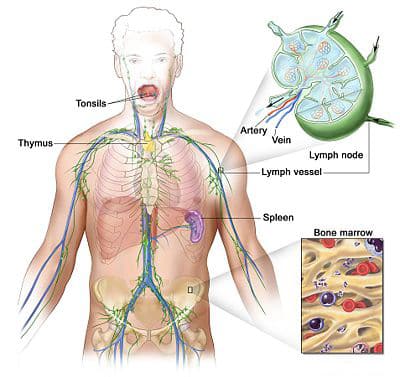The Lymphatic System is very important. It helps with the Cardiovascular system, and our immune systems. The Lymphatic System is made up of two semi-independent parts. One is a network of lymphatic vessels. The other part is various lymphoid tissues and organs all over the body. The functions of the Lymphatic System transporting fluids that have escaped from the blood vascular system, and the organs house phagocytic cells and lymphocytes. Lymphatic vessels are an elaborate system of drainage vessels that collect the excess protein-containing fluid and returns it to the bloodstream.. Once an interstitial fluid enters the lymphatics it is called lymph. The lymphatic vessels form a one way system in which lymph flows only towards the heart. This entire transport system starts in the lymph capillaries. These are very common, usually occur in the places blood capillaries occur. Lymph capillaries are not found in bone, teeth, bone marrow, and entire central nervous system.
Lymphatic capillaries are very permeable. The endothelial cells that make up the walls of the capillaries are not tightly joined.  Filament anchor the endothelium cells so they can expand. Pathogens can spread through the body through the lymphatic stream. There are many cells in the lymphoid tissue. One type is lymphocytes, which are referred to often as T or B cells. Plasma cells are antibody-producing offspring of B cells. Macrophages are phagocytes that help out with immunity. Reticular cells are cells that form the lymphoid tissue stroma. These cells are very important parts of the immune system. The Lymphatic System also contains tissues. The tissue of the Lymphatic System is reticular connective tissue. It hold the macrophages and changes the number of lymphocytes. It is an important part of the immune system. The Lymphoid tissue can be found in the follicles. Lymphoid organs are discrete and encapsulated. The main lymphoid organs are the spleen, tonsils, thymus and lymph nodes. The lymph nodes are placed along the lymphatic vessels. Each node has a fibrous capsule, a cortex, and a medulla. The lymph nodes circulate fluids. The lymph enters the lymph nodes through afferent lymphatic vessels and exits through the efferent vessels.(afferent=enter, efferent=exit) Most lymphoid organs contain both macrophages and lymphocytes. The spleen is a place for immune function, and it kills defective or aged red blood cells and blood-borne pathogens.
Filament anchor the endothelium cells so they can expand. Pathogens can spread through the body through the lymphatic stream. There are many cells in the lymphoid tissue. One type is lymphocytes, which are referred to often as T or B cells. Plasma cells are antibody-producing offspring of B cells. Macrophages are phagocytes that help out with immunity. Reticular cells are cells that form the lymphoid tissue stroma. These cells are very important parts of the immune system. The Lymphatic System also contains tissues. The tissue of the Lymphatic System is reticular connective tissue. It hold the macrophages and changes the number of lymphocytes. It is an important part of the immune system. The Lymphoid tissue can be found in the follicles. Lymphoid organs are discrete and encapsulated. The main lymphoid organs are the spleen, tonsils, thymus and lymph nodes. The lymph nodes are placed along the lymphatic vessels. Each node has a fibrous capsule, a cortex, and a medulla. The lymph nodes circulate fluids. The lymph enters the lymph nodes through afferent lymphatic vessels and exits through the efferent vessels.(afferent=enter, efferent=exit) Most lymphoid organs contain both macrophages and lymphocytes. The spleen is a place for immune function, and it kills defective or aged red blood cells and blood-borne pathogens.
The spleen also stores platelets, products of hemoglobin, and acts as hematopoietic sites in the fetus. The Thymus contains hormones. It is mostly functional in youth. Peyer’s patches are on the tonsils, intestional wall, lymphatic nodules of the appendix and nodules of the respiratory tract. (MALT) The many functions of the lymphatic system help the body to maintain body homeostasis. Some of the functions are removing foreign matter, maintain correct blood volume, and very important in immunity.

Thank you!
Super!
Excellent!